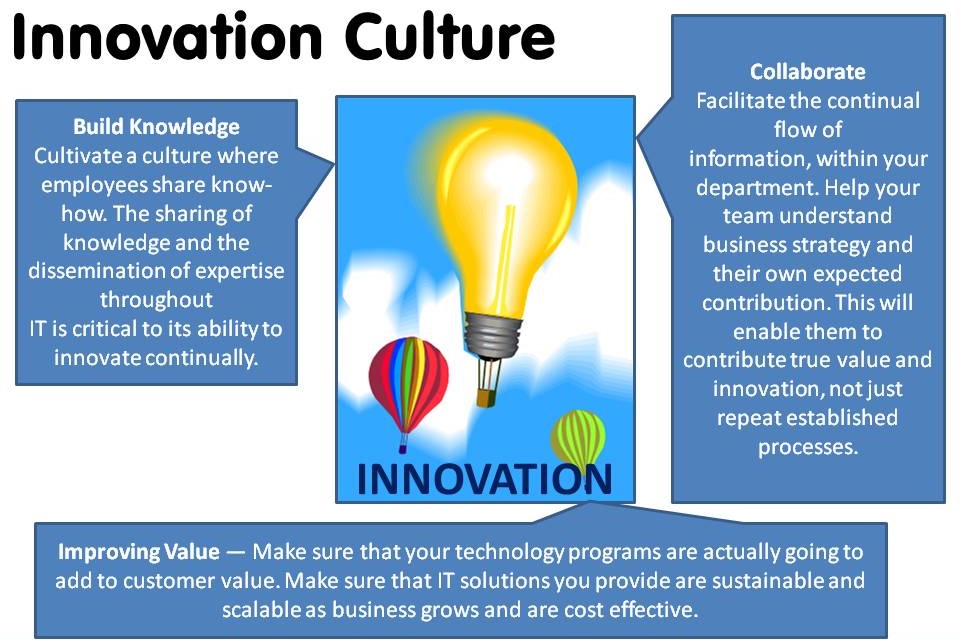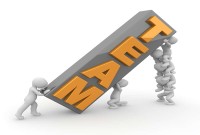- Home
- Business Processes
- Industry Knowledge
- Aerospace Industry
- Automotive Industry
- Banking Domain
- BFSI Industry
- Consumer/ FMCG Industry
- Chemicals Industry
- Engineering & Construction
- Energy Industry
- Education Domain
- Finance Domain
- Hospitality Domain
- Healthcare Industry
- Insurance Domain
- Retail Industry
- Travel and Tourism Domain
- Telecom Industry
- Leadership Skills
- eLearning
- Home
- Leadership Skills
- Strategy Tools
- Change & Culture of Innovation
Change & Culture of Innovation
Predicting the future is a tricky business but managers need to have a future perspective in order to take business advantage and remain competitive. They need to drive and introduce constructive change to the business of the enterprise. The first step to creativity and innovation is to drive a culture of Innovation. Managers need to focus on developing future mindset all the time to keep pace with the unfolding future.
One needs to have some broad awareness of whether the future is tending.
Changing Customer Needs
There are thousands of services, from the provision of spectacles to the development of your holiday plans, where the customer wants instant results. The industry-wide waiting time is fast reducing from days and hours to minutes. A conceptual shift is needed in the manager’s mindset to drive change toward getting as close as possible to an immediate meeting of the customer's needs.
Response time is getting better in the banking industry. Most banks provide the facility of instantaneous account debiting by automatic tellers at any time of day or night. In Manufacturing industries, the time value of information is gaining respect, and monitoring of the production line is in real-time. Service industries are trying to answer a business query immediately which is in turn, beneficial for both the customer and the provider. Computer-aided design and development is enabling the culture of straight to production and consumption. Innovation is constantly driving change across all industries.
Anyplace Customers want the service where they want it. They don't just want it where the supplier thinks it's convenient to hold it. They want it at anyplace. Already there are plenty of examples of this. Mobile has replaced so many gadgets like phone, pocket calculators, camera, heart monitors, step trackers, computers and desktops, etc. Earlier we would have had to go to the office to use a desk one for sending emails. Month by month the number of people who carry the phone around with them is growing, and they no longer have to go to where the phone is. They practically wear it. Portable computers of the lap variety enable business people to do their spreadsheets on the plane; home entertainment systems are now designed for self-assembly, so that you no longer have to wait for the technician but within an hour of purchase you are enjoying the fruits of your investment, having taken it home in two or three boxes in the car.
The customers today do part of what would previously have been done at the factory. The manufacturing chain of the goods and services ends in the hands of the consumer in their own physical space. Those who provide goods and services in a real-time gain a competitive edge over those who don't there is no time lag between the identifying of a need and its fulfillment.
Technology is Unfolding Future
The technology is there. It is simply that managerial thinking hasn't caught up with it. This is where future mindset comes in, developing all the time to keep pace with the unfolding future. The ability to provide the product in any place is facilitated by the advancement in electronics, whereby a million electronic components can be placed on a quarter of inch square of smelted sand. The information carried by electrical impulses demolishes space as well as time so as enables the customers to enjoy both benefits. No doubt all these innovations brought a lot of unwelcome change to those who preferred the status quo, but those with the future mindset like Apple, Google, and others not only survived but prevailed and emerged as winners.

Concept of Anytime Anyplace
There always existed an interrelationship between physics and management. Both physics and management are concerned with "the interrelationships of the parts with a whole". Time, space, and matter are fundamentals of physics, as equally fundamental to the shaping of tomorrow's business and organizations. The first dimension of physics which links with business needs is time. As we respond to and persuade customers, they use time until they decide to buy. Then we deliver, we are using theirs. We have to shorten the elapsed time between their decision and the fulfillment of their need. The customers want the product of service when they want it, not when the company deigns to provide it. They want it any time, and as explained above, technology already provides many examples of meeting this need.
These concepts of any time and any place are changing the way organization operates:
- It is becoming less significant where you work. Half of the world was working from home during the recent COVID-19 pandemic
- The number of home workers is on the increase, with the ultimate benefit to transport problems as the people working away on their computers.
- The human association is provided by the increasing speed of network connectivity
- Decentralization is happening, which is after all about the place
- As people work in networks, less dependent on space, so headquarters building is less inhabited and organizational hierarchies flattened
- Middle managers find a new place between the producers and the customers, instead of between the senior managers and the supervisors.
Building Innovation Mindset
Managers need to focus on building innovation culture by facilitating collaboration across organizations, building the breadth and depth of knowledge, and improving the value that any function provides to the business. They need to facilitate the continuous flow of information, within their departments. Help their team understand business strategy and their own expected contribution. This will enable them to contribute true value and innovation, not just repeat established processes.
Cultivate a culture where employees share know-how. The sharing of knowledge and the dissemination of expertise throughout the organization is critical to its ability to innovate continually. Make sure that your change initiatives and programs are actually going to add to customer value. Make sure that solutions are sustainable and scalable as the business grows and are cost-effective.
Related Links
You May Also Like
-
Time management is the process of planning and exercising conscious control of time spent on specific activities, especially to increase effectiveness, efficiency, and productivity. The best time management techniques improve the ways you work. Time management refers to managing time effectively so that the right time is allocated to the right activity. Learn more about the five steps for effective time management viz. study, identify, analyze, decide, and implement.
-
At different points in your professional career, it is helpful to identify your core values. Values are the qualities considered to be the most important guiding principles that determine the priorities in your life and greatly influence your career choices. Your career brings happiness when it is in agreement with the beliefs you have about what is important and meaningful to you. Awareness of your values will help you develop a clearer sense of what's most important to you in life.
-
Thinking & Problem Solving Skills
Today's dynamic business world demands that you make decisions that significantly boost productivity and drive competitive advantage. But how do you know whether a decision will benefit the organization? And how do you know that the decisions are based on rational and statistical reasoning? Explore how to become a dynamic problem solver with the skills to make accurate decisions.
-
Generating Ideas using Brainstorming
The brainstorming technique was developed by Alex F. Osborn in 1957 and brainstorming means where a team of members generates a large amount of alternative fruitful ideas on a specific problem without any criticism and then evaluates each idea in terms of their pros and cons. Brainstorming techniques fall into four broad categories: visioning, exploring, modifying, and experimenting.
-
Charles Darwin had once commented that “It is not the strongest or the most intelligent who will survive but those who can best manage change.” Agility means the capability of rapidly and efficiently adapting to changes and recently, agility has been applied in the context of software development, agile enterprise, and agile leadership. Agile leaders play an important, even essential, role in scaling agility in an organization. Understand how being an agile leader helps in effectively catalyzing organizational change.
-
Creating Highly Effective Teams
How do we create effective teams? What comes to mind when you think about an effective team? High performing teams exhibit accountability, purpose, cohesiveness, and collaboration. It is a team that works seamlessly as a whole. Everyone brings unique talents and strengths and support each other to bring out the best in everyone. How do you create one?
-
Crisis leadership is a very important part of leading in today's world. The skills a leader needs in order to guide people during a crisis are different from the skills needed to help a group grow. Are you a good crisis leader? What is your leadership style in case of a business crisis situation? A business crisis can test the strongest of leaders, read this article to explore how to ensure you’re ready to take action and weather the storm when one strikes you.
-
Team Foundation in Forming Stage
This is the first stage of team development. This is the stage when the foundation of the team is laid. During the Forming stage, team members have a high dependence on their leader for guidance. Learn the practical strategies you can use during this stage to help your team develop into a highly effective performing team.
-
Storming Stage of Team Development
Storming is the second stage of team development and this stage is characterized by a bid for power and inter-personal conflicts. Learn the key factors that occur in the storming stage and the strategies that a team leader can adopt to pass this stage of high winds
-
Collaborative leadership is all about collaborative problem-solving and decision-making or can also be defined as the leadership of a collaborative effort. . The term started to appear in the mid-1990s in response to the formation of long term public-private partnerships to rebuild public infrastructure. Learn how you can use principles of collaborative leadership to enhance your leadership skills for being an effective leader.
Explore Our Free Training Articles or
Sign Up to Start With Our eLearning Courses

About Us
Learning
© 2023 TechnoFunc, All Rights Reserved










